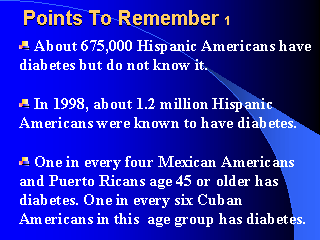|
|
|
|
front |1 |2 |3 |4 |5 |6 |7 |8 |9 |10 |11 |12 |13 |14 |15 |16 |17 |18 |19 |20 |21 |22 |23 |24 |25 |26 |27 |28 |29 |30 |31 |32 |33 |34 |review |
 |
Native-Americans and Type 2 Diabetes Mellitus:
The literature also suggests that Native-Americans have a higher risk of developing Type 2 diabetes than the general American population, especially those with a family history of the disease. Moreover, a number of studies have suggested that individuals of Mexican ancestry who have inherited a mixed pool of European and Amerindian genes have a greater propensity to develop Type 2 diabetes. The term Native-American is used here to refer to specific groups of people in the United States, such as the Navajo, Apache, and Pima, whose ancestry is derived from the prehistoric settlers, the Amerindian, of the Western Hemisphere. The results of an ongoing longitudinal study of a group of Native Americans, the Pima people, suggest that the development of Type 2 DM was familial and its incidence was associated with parental diabetes, body mass index and age. It was also found that the risk of developing Type 2 DM was highest for individuals with two diabetic parents. Additionally, the offspring of a diabetic mother has a higher prevalence of Type 2 DM than the offspring of a pre-diabetic mother, and this offspring has a higher prevalence of Type 2 DM than the offspring of a non-diabetic mother. These and other studies have revealed an increase in the incidence and the prevalence of Type 2 DM in the recent past and that Type 2 DM is a growing problem in Native-American populations who share an Amerindian ancestry. Given that the research conducted among the Pima people has been extensive and significant, certain public health issues and concerns have not been fully addressed in the literature, among them public health promotion, prevention, and control programs that emphasizes how, where and why Type 2 DM develops in the Pima's social, economic and cultural environment. In other words, the studies reviewed point to the need for further research on the behavioral, social, and economic factors as they affect this particular group of Native-Americans, in order to further understand the impact of these factors on their health care needs. A subsequent assessment of the relationship between diabetes and gallbladder disease demonstrated an odds ratio of 2.4 among diabetic females with gallbladder disease. In another study, it was found that Amerindian admixture, measured through the use of genetic markers in a sub-sample of the diabetics and gallbladder disease subjects and their relatives, was 35 percent in these groups. The investigators found that prevalence of gallbladder disease was higher among subjects with the highest Amerindian background although the results of a test of linear trend were not significant. An interesting and significant diabetes and gallbladder disease study was conducted in a community near Albuquerque, New Mexico, from July 1984 through November 1985. The highest gallbladder disease rates were among females and the females in the study had higher prevalence rates of diabetes for all age groups between 35 to 75 years than males. The highest rate was reported by females in the 75(+) years age group at 16.1 percent. Among the males in the 75(+) years age group, the highest diabetes prevalence rate was 13.8 percent. |